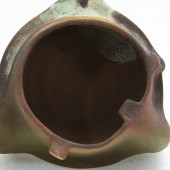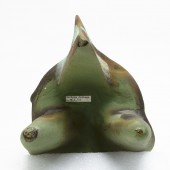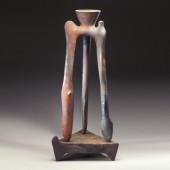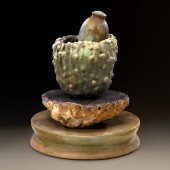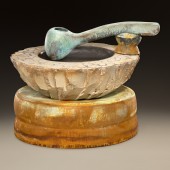![]() Printer version
Printer version
Richard A. Hirsch, Rick Hirsch
1944 Born New York, New York
EDUCATION
1966 BS Art Education, State University of New York, New Paltz, New York
1971 MFA Ceramics, School for the American Craftsmen, Rochester Institute of Technology, Rochester, New York
2008 Honorary Ph.D. Taiwan National University of the Arts, Taiwan
PRIMARY WORK EXPERIENCE
1966-1968 Teacher, Junior High School, Newburgh, New York
1972-1974 Ceramic Master, Sault College of Applied Arts and Technology, Sault Ste. Marie, Ontario, Canada
1975-1985 Associate Professor of Ceramics, Program in Artisanry, Boston University- Franklin Institute Projects, Boston, Massachusetts
1987-2014 Professor Emeritus, School for American Crafts, Rochester Institute of Technology, Rochester, New York
BIOGRAPHY
Richard Hirsch’s works are typically made using earthenware to which he adds talc and spodumene. The complex colors seen on his pieces are the result of the application of multiple layers of slips and glazes. A piece is often fired between the layers. Finally, each piece is finished in a raku firing, a technique Hirsch developed to create the surface patina seen on ancient ceramic wares.
Richard Hirsch’s work traces the evolution of the vessel through explorations of vessel forms from various cultural traditions. These range from ancient Chinese bronze tripod vessels to wares used in the the16th-century Japanese tea ceremony, to Pre-Columbian clay vessels and contemporary ceramics such as the modernist sculptures of Constantin Brancusi.
Beginning in the 1990s, Hirsch’s works became larger, incorporating multiple sections and forms including blades, mallets, and mortar and pestle. Hirsch also began to incorporate forged iron, glass, and other mixed-media elements in his stacked and arranged series of vessels during this period.
For three decades Hirsch managed to balance a career in the studio with one in the classroom. He was a sought-after teacher wherever he taught until his retirement in 2014. His students include: Rau Chen, Ching-Yuan Chang, Kendra J. Conn, Kelli Damron, Andrew Denney, E. Blaise DePaolo, Lisa Tully Debble, Jeremiah Donovan, Moi Dugan, D. Leslie Ferst, Rod Guyer, Abby Huntoon, Ho-Jeong Jeong, Do-Sik Kang, Jeff Kell, Christopher Kelly, Ray Liao, Leigh Taylor Mickelson, Jill Oberman, Toshio Ohi, Erin O’Sullivan, Scott Place, Chloe Rizzo, Paul Sacaridiz, Preston Saunders, Ellen Schön, Tracy Shell, Marvin Sweet, Trevor Tait, Julie Terestman, Charles Washburn, James R. White, Robin Whiteman, Bruce M. Winn, Bok-Ja Won, Graham Yeager, and Hyuejin You.
PUBLIC COLLECTIONS
Art Gallery of Greater Victoria, Victoria, British Columbia, Canada
Benaki Museum, Athens, Greece
Boca Raton Museum of Art, Boca Raton, Florida
Burchfield Penney Art Center, Buffalo, New York
Carnegie Museum of Art, Pittsburg, Pennsylvania
Ceramic Research Center, Arizona State University, Tempe, Arizona
China Art Academy Museum, Hangzhou, China
Daum Museum of Contemporary Art, Sedalia, Missouri
Everson Museum of Art, Syracuse, New York
Fuller Craft Museum, Brockton, Massachusetts
Gardiner Museum of Ceramic Art, Toronto, Ontario, Canada
High Museum of Art, Atlanta, Georgia
Honolulu Academy of Art, Honolulu, Hawaii
lcheon World Ceramic Center, Gyeonggi-do, South, Korea
Memorial Art Gallery, University of Rochester, Rochester, New York
Mint Museum, Charlotte, North Carolina
Museum of Arts and Design, New York, New York
Museum of Fine Arts, Boston, Massachusetts
The National Museum of Art, Riga, Latvia
Nelson-Atkins Museum of Art, Kansas City, Missouri
New Orleans Museum of Art, New Orleans, Louisiana
Nora Eccles Harrison Museum of Art, Utah State University, Logan, Utah
Ohi Museum, Kanazawa, Japan
Racine Art Museum, Racine, Wisconsin
Ruth Chandler Williamson Gallery, Scripps College, Claremont, California
Seoul National University, Seoul, Korea
Sorlandets Kunstmuseum, Kristiansand, Norway
Taipei Country Yingge Ceramics Museum, Taipei, Taiwan
BIBLIOGRAPHY
Andrews, Tim. Raku, 2nd ed. London, England: A&C Black, 2005.Cooper, Emmanuel. Ten Thousand Years of Ceramics. London, England: The British Museum Press, 1999.
Hirsch, Richard. “The Raku Family Tradition.” Studio Potter (January 1979).
____________ and C. D. Tyler. “The Nature of Raku.” Craft Dimensions (February 1974).
____________ and C. D. Tyler. Raku. New York, NY: Watson-Guptill, 1975.
Hopper, Robin. The Ceramic Spectrum. Radnor, PA: Chilton Book Company, 1983.
Hunt, Bill. 21st Century Ceramics. Westerville, Ohio: The American Ceramics Society, 2003.
Jones, David. Firing: Philosophies within Contemporary Ceramic Practice. Marlborough, England: Crowood Press, 2008.
Jones, David. Raku: Investigation into Fire. London, England: Crowood Publishing, 1999.
Lane, Peter. Ceramic Form. New York, NY: Rizzoli International Publications, Inc., 1990.
Levin, Elaine. The History of American Ceramics: From Pipkins and Bean Pots to Contemporary Forms, 1607 to the Present. New York, NY: Harry N. Abrams, Inc.,1988.
Manheimer, Marcia and Tom Manheimer, The Eloquent Object. Seattle, Washington, The University of Washington Press, 1987.
Meyer, Scott. "With Fire" Richard Hirsch. A life Between Chance and Design. Rochester, NY: The Carey Press, Rochester Institute of Technology, 2013.
Ming, Bai. World Famous Ceramic Artists Studio'sVolume of America. Beijing, China: Fine Art and Photography Publishing House, 2005.
_______. Oversea Contemporary Ceramic Art Classics. Beijing, China: Fine Art and Photography Publishing House, 2002.
_______. World Contemporary Ceramics: A Brief Introduction. Peoples Republic of China: Jiangxi Art Publication, 1999.
Peterson, Susan. Contemporary Ceramics. New York, NY: Watson-Guptill, 2000.
Raku: Origins, Impact, and Contemporary Expressions. Eagleheart Center for Art and Inquiry, Grand Junction, Colorado, 2005.
Rhodes, Daniel revised and expanded by Robin Hopper. Clay and Glazes for the Potter, 3rd ed. lola, WI: Krause Publications, 2000.
Shin, Sang-Ho. Contemporary Ceramics: A Step Toward the Future. South Korea: Hong-lk University Press,1997.
Sweet, Marvin. The Yixing Effect: Echoes of the Chinese Scholar. Beijing, People's Republic of China: Foreign Language Press, 2006.
The Uncommon Denominator: A Tribute to Richard Hirsch. Rochester, NY: Rochester Institute of Technology, Cary Graphic Arts Press, 2005.
Watkins, James and Paul Wandless. Alternative Kilns and Firing Techniques. New York, NY: Lark Books, 2004.
Wechsler, Susan. Low-Fire Ceramics: A New Direction in American Clay. NewYork, NY: Watson-Guptill, 1981.
Zakin, Richard. Electric Kiln Ceramics. Columbus, OH: The American Ceramics Society, 2015.
___________. Ceramics: Ways of Creation. lola, WI, Krause Publications, 2002.
___________. Electric Kiln Ceramics. lola, WI, Krause Publications, 2004.
Zhou, Guangzhen. American Ceramics Artist Today. Beijing, China: Peoples Artistic Corp.,1998.
______________. The Masters of International Ceramic Art and Their Works. Shanghai, China: Shanghai Fine Art Publishers, 2006.
Method: Hand-Built (Blue-green terra sigilattas, cupric sulfate spray, paint dope.)
Surface Technique: Terra Sigillata
Citation: "The Marks Project." Last modified July 28, 2023. http://www.themarksproject.org:443/marks/hirsch




